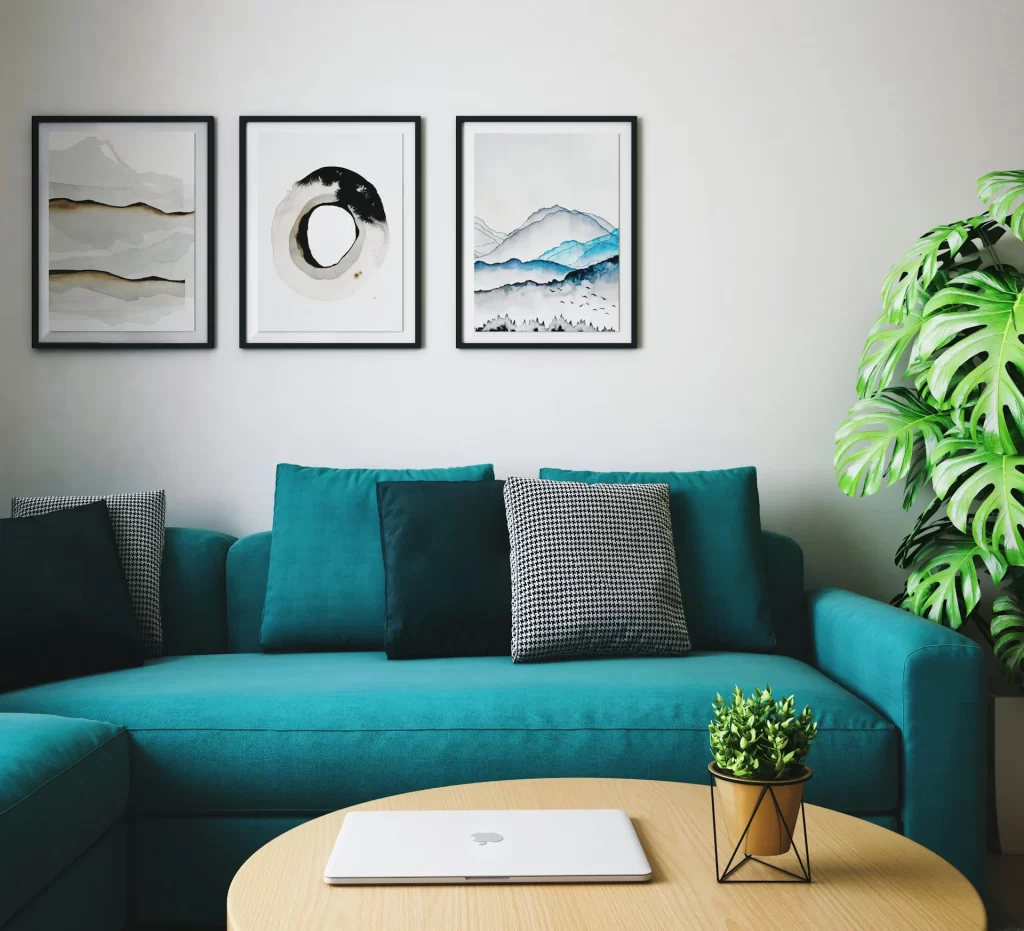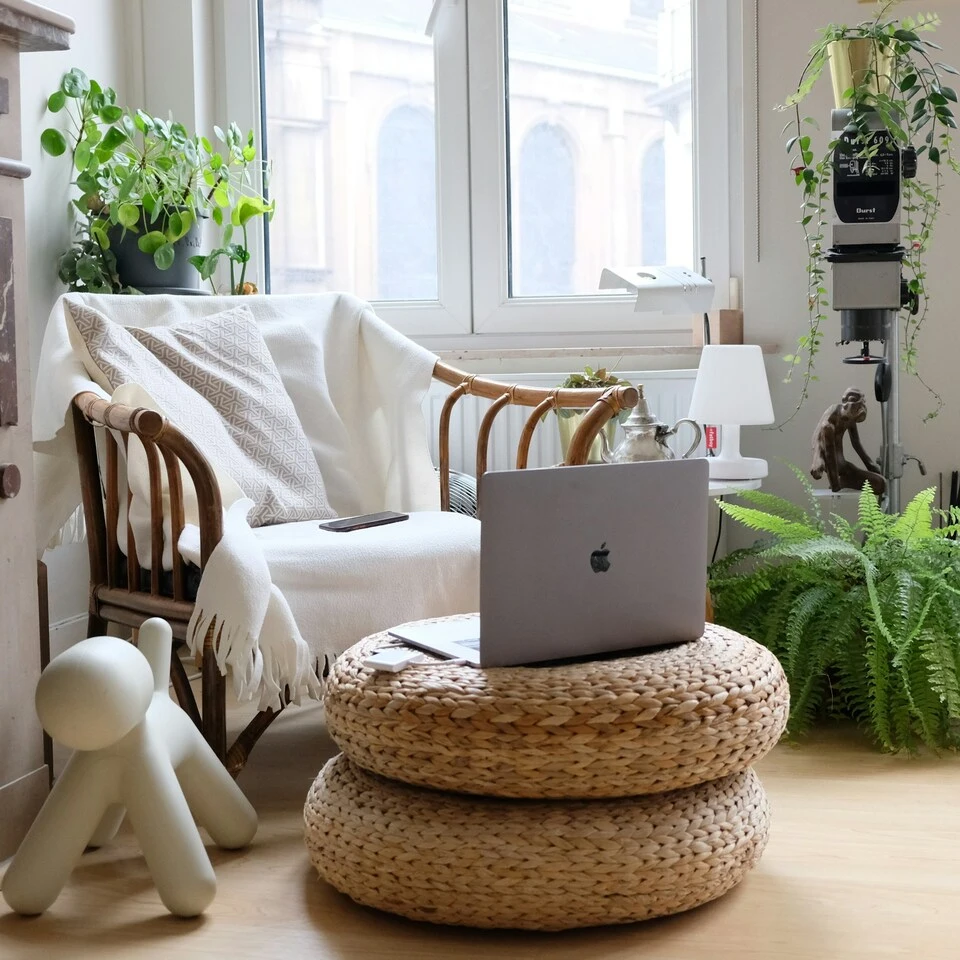
Making an office space in the living room is not as easy as it sounds. It’s something most of us probably thought about but never executed well.
While the living room is typically the largest area in a home, carving out a productive space may not be an easy feat. Perhaps, you encounter difficulties such as limited space, poor lighting, unsuitable furniture, or the challenges of sharing space with another person.
If this sounds like a familiar struggle, fret not.
We’ll explore how to fit an office in a small living room, from creating a dedicated workspace to merging productivity with the ambiance of your living area.
The key lies in making the right furniture choices and prioritizing functionality over mere aesthetics.
Making an Office Space in the Living Room
No matter how limited the space is, creating a functional office space in your living room is a matter of thoughtful planning. To create a workspace, the primary consideration revolves around deciding where to place your desk.
To place a desk in a small living room, explore an unused corner or an empty wall. If you need to make space, use space-saving furniture like foldable or wall-mounted desks, and consider rearranging storage items or furniture. For instance, move your sofa, so that you can place a desk behind it.
Here are some strategies to maximize your space.
Choose the Right Location
The first step to fitting an office into your small living room is choosing the right spot.
Generally, here’s what you can do to maximize your living room without any extensive transformations: Look for a corner or nook that is underutilized or has the potential for dual-purpose functionality. Corners are often your best choice as they allow you to maximize space without impeding the primary functions of the living area.
Most of us have an overlooked corner within our homes. With a bit of rearranging, a corner nook could be repurposed. Sometimes, it may require nothing more than shifting a cabinet or sofa to free up the space. I have done this myself, shifting a small cabinet to accommodate a desk right beside a window.
Utilizing vertical wall space can also be a smart move, with wall-mounted shelves and storage solutions.
With a few tweaks, you’ll be pleasantly surprised to discover a conducive spot for your desk. It might not be your ideal spot, but you can always enhance it later with proper lighting, ventilation, and personal touches.
This article was originally published on unboundist.com. If it is now published on any other site, it was done without permission from the copyright owner.
Furniture Choice and Placement
Choosing the right type of furniture is crucial. Sometimes you need to make tweaks and adjustments to your existing furniture.
Not everyone thinks about furniture choices when it comes to making a living space functional for productivity. One might stick with an existing desk or try to work on the couch. The reality is that you have more options than that. For example:
- You can choose an L-shaped corner desk instead of a standard coffee table.
- You can replace one of your sofas with an ergonomic chair if you’ll be working in it regularly.
- More on furniture options in the next section.
Furniture placement is also important. You do not want to obstruct yourself or your family members or flatmates.
Face your desk away from the TV if the TV is a source of distraction.
Don’t cramp too much in one space – you do not want to trip and fall.
If you are living with others, do not have your devices or items hanging off the sides of your desk, so that they do not get knocked by someone else.
Organizing and Decluttering
Decluttering the living room office is key to preventing it from feeling cramped and chaotic.
You may have to shift one or two comfort or aesthetic items out of the living room, to make more space for your desk or to declutter your living room office. Do that. The principle when designing a multifunctional space is to prioritize functionality over aesthetics.
The next consideration is storage. Make use of filing cabinets or shelves.
Cabinets are best to keep any office and general items hidden from view, so your living room space can appear neat and clean. Shelves work too since they maximize the walls.
One thing that causes mess is cables. Hide cables and cords as much as possible. Ideally, your desk space should be situated near a power outlet. However, if this isn’t the case, you could either use a long extension cord or find alternative solutions for cable management.
Functional and Space-saving Furniture
To make your small living room office more efficient, consider investing in: 1) space-saving furniture, 2) multi-purpose furniture, 3) ergonomic furniture, and 4) lighting.
Invest in Space-Saving Furniture: Opt for space-saving furniture, such as wall-mounted desks or corner desks. Wall-mounted desks save floor space, while corner desks like an L-shaped desk can maximize an unused corner while providing ample space for productivity.
Another option is foldable desks. Opt for tables that can be folded away when not in use, providing more space for your living area.
Use Multi-Functional Furniture: To maximize space, choose multi-functional furniture pieces.
For example, go with a sofa with built-in storage, an ottoman that doubles as a coffee table, or a bookshelf that can serve as both storage and a room divider.
If your furniture serves multiple purposes, you can maximize your existing space without introducing new elements and potential clutter.

Consider ergonomics: Working from home can be tough. Good ergonomics make productivity more enticing and support your health during longer work hours.
Invest in ergonomic furniture like a laptop stand, or even an adjustable desk.
As mentioned, you can replace your comfort couch with an equally or even more comfortable ergonomic chair. These are proper office chairs with lumbar support and adjustable components like seat height and armrest positioning.
Key consideration: Once more, ergonomics become more significant if you are making lasting adjustments rather than temporary changes for the occasional living room digital grind. If you intend to work all day in your living room, transform it into a proper office by prioritizing comfort and functionality.
Alternative desks: You could use alternative furniture and tools as desks, such as an ironing board (I’ve discussed separately how to make this work) and mobile mini-desks like a rollable side table. You can easily position the rollable side table for work at any living room sofa, couch, or chair.
The beauty of these alternative, though imperfect mini-desk spaces is that you get more flexibility. You have more options for setting up your workspace and switching things up.
Related: 10 Alternative Ways to Productively Work Without a Desk
Proper lighting: If you can, make the most of natural light by positioning your desk near a window.
If natural light is limited, use task lighting to illuminate your workspace without necessarily intruding on the rest of the room.
Ensure you have cool lighting (blue-white light) for work and not just warm light colors – those are best for rest.
While adjustable lighting is great, wall-mounted or recessed lights will save space on your desk.
Seamlessly integrating productivity with the living area
Integrating an office into your small living room may seem challenging, especially when you share the space with others. Here are some more ideas on how to make your workspace non-intrusive. Perhaps, you’d like a small workspace that can be hidden and tucked away from sight when not in use.
To conceal your home office in your living room:
- Use a rollable side table for your desk. This lets you work from the sofa. Tuck it away when not in use.
- Set up a light foldable table. Such a table is easy to fold, keep, and hide once your work gets done.
- Work on wall-mounted shelves. For a living room, wall-mounted shelves look sleek and appropriate. Transform the “mood” by placing decorative items and plants on these shelves, once you are done with work.
- Place a laptop stand on your coffee table. A laptop stand can make lower surfaces functional, such as your coffee table, even though they are not designed for work.
- Use an ironing board as a standing desk. It provides just enough space for a laptop, mouse, and a tablet or phone. Standing at your ironing board, you can further prop up your laptop using blankets, folders or briefcases, to get it raised to the right height.
- Get a mobile laptop desk. Such desks with wheels are small, portable, and some are even height adjustable to suit your height and sit-stand needs. They are easily tucked away after use.
- Set up a standing desk converter atop a cabinet. This can be the makeshift option for your standing desk.
- Set up an L-shaped desk. An L-shaped desk is great for a corner office in your living room, especially if space is tight.
- Use room dividers, shelving, or curtains. Such tools can create a visual separation between your workspace and the living area. When your workday is over, simply close these dividers to “hide” your office.
As you can see, there are many ways to make your home office blend more seamlessly with the living room, if this is what you like. Built-in furniture and shelving can blend seamlessly with your living room’s design.
For more personalization, you can make your living room workspace feel like an organic part of the living room. Personalize it with decor items, artwork, and accessories that inspire you and make the space feel like your own. A personalized workspace can boost your productivity and overall well-being.
If you want more tips on setting up your home office, check out our comprehensive guide to get your workspace up and ready in no time.